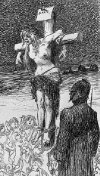Loxuru
Graf von Kreuzigung
A little bit of history
On October 7th 1915, exactly a hundred years before the date of this post, the Central Powers invaded Serbia. Earlier, during the first months of the Great War, Serbia had succeeded to push back a first attempt by the Austro-Hungarian armies to conquer the country.
It should be reminded that the war had escalated from a conflict between Austria-Hungary and Serbia, after the assassination of the Archduke Franz-Ferdinand, heir to the Austro-Hungarian throne, and his wife, by Serbian nationalists, in Sarajevo on the 28th of June 1914. One month later, on the 28th of July 1914, Austria-Hungary declared war to Serbia, and the same day, the first shells of the war fell on the Serbian capital of Belgrade.
After the defeat in 1914, the Austro-Hungarian Empire still had a score to settle with Serbia. The campaign of 1915 was carried out from two directions. From the north, Serbia was invaded by a combined force of Austro-Hungarian and German armies. One of the Austrian army commanders was General Oskar Potiorek, who had been sitting in the same car as the Archduke, when Gavrilo Princip had fired his gun on that fatal day in Sarajevo. From the east, the Bulgarian army attacked. Bulgaria had just joined the Central Powers, and had also bills to settle with Serbia, from the Balkans War two years earlier.
Against this force, the Serbian army was no match, and the country was overrun. Serbia would face harsh years of occupation, executions, food shortages and ensuing diseases. It would end the war with the highest death toll rate of both its armed forces (about one in four) and of its overall population (at least on in six) of all war faring countries.
France and Britain sent an expeditionary force to help Serbia, but it was only a small one. Furthermore, they made the strange decision not to go by the shortest way, trough Montenegro, their other ally on the Balkans, ignoring Montenegro's offer to protect allied landings on the Dalmatic coast. Instead, they choose to go through Greece. Although Greece was neutral, the pro-allied government had given permission to use the port of Saloniki for the allied landings. This was however against the will of the pro-German king of Greece. The allied landings worsened the constitutional conflict between the king and his government. As a result, the expeditionary force had to stay in Saloniki. They would not come too late, they just would not come at all to support the Serbian army.
The collapse of Serbia did not go unnoticed at the allied home front. Campaigns were rallied to support Serbia. Serbian soldiers, evacuated after the defeat of their country, paraded over the Champs-Elyzées in Paris. One of the men who engaged himself in the propaganda campaign, was the Swiss-born artist Théophile-Alexandre Steinlen (1859-1923). Steinlen was an artist, living in Montmartre, Paris, in the neighbourhood of Toulouse-Lautrec and a young Picasso, whom he influenced. His work was various : paintings, posters, drawings, lithographs,… His work was typical for the Art Nouveau period before the war. Steinlen had acquired the French nationality, and in 1914, although already over 50 years old, he had not hesitated to join the French army.
During the war, he painted the soldiers in the trenches, and the civil populations hit by the war. After the defeat of Serbia, he depicted the misery of the Serbian people and made some propaganda drawings and posters, calling for support to the Serbian cause.
Probably his most outstanding and expressive work on the Serbian defeat was a 1916 lithograph, known as ‘Crucified Serbia’. It depicts Serbia as a woman, crucified naked on a timber wall (a barn?) with bayonets through her hands and through the thighs of her spread legs.
The lithograph showed typical propaganda elements of the time. The defeated country, overrun by the ‘barbarian’ Central Powers was represented as a raped, tortured, humiliated woman (analogue to ‘the Rape of Belgium’). It appears that during the Great War, crucifixion was a very touching propaganda item against the Central Powers. Steinlen’s depiction strongly appeals to an atrocity propaganda story about a Canadian soldier allegedly having been crucified by Germans. The story of that event, dated in April 1915 near Ypres, mentions a soldier having been crucified alive, with bayonets, to a barn. However, the story has never been confirmed. Different versions exist. The soldier has never been identified, there are uncertainties about the place, and whether that place has ever been in the hands of the German army during the battle. But no doubt, Steinlen was inspired by the story.
Meanwhile, Steinlen’s lithograph even served more propaganda causes. The French sculptor and medalist Ovide Yencesse (1869-1947) casted a medal, showing Steinlen’s crucified Serbia on one side and the text “France France, ne m’abandonne pas” (France, don’t let me down) on the backside. Apparently, these medals were sold to raise funds to support Serbia. Today it seems to be a rather rare collector’s item.


(having found no indication that this has been posted before on CF)
(to be continued)
On October 7th 1915, exactly a hundred years before the date of this post, the Central Powers invaded Serbia. Earlier, during the first months of the Great War, Serbia had succeeded to push back a first attempt by the Austro-Hungarian armies to conquer the country.
It should be reminded that the war had escalated from a conflict between Austria-Hungary and Serbia, after the assassination of the Archduke Franz-Ferdinand, heir to the Austro-Hungarian throne, and his wife, by Serbian nationalists, in Sarajevo on the 28th of June 1914. One month later, on the 28th of July 1914, Austria-Hungary declared war to Serbia, and the same day, the first shells of the war fell on the Serbian capital of Belgrade.
After the defeat in 1914, the Austro-Hungarian Empire still had a score to settle with Serbia. The campaign of 1915 was carried out from two directions. From the north, Serbia was invaded by a combined force of Austro-Hungarian and German armies. One of the Austrian army commanders was General Oskar Potiorek, who had been sitting in the same car as the Archduke, when Gavrilo Princip had fired his gun on that fatal day in Sarajevo. From the east, the Bulgarian army attacked. Bulgaria had just joined the Central Powers, and had also bills to settle with Serbia, from the Balkans War two years earlier.
Against this force, the Serbian army was no match, and the country was overrun. Serbia would face harsh years of occupation, executions, food shortages and ensuing diseases. It would end the war with the highest death toll rate of both its armed forces (about one in four) and of its overall population (at least on in six) of all war faring countries.
France and Britain sent an expeditionary force to help Serbia, but it was only a small one. Furthermore, they made the strange decision not to go by the shortest way, trough Montenegro, their other ally on the Balkans, ignoring Montenegro's offer to protect allied landings on the Dalmatic coast. Instead, they choose to go through Greece. Although Greece was neutral, the pro-allied government had given permission to use the port of Saloniki for the allied landings. This was however against the will of the pro-German king of Greece. The allied landings worsened the constitutional conflict between the king and his government. As a result, the expeditionary force had to stay in Saloniki. They would not come too late, they just would not come at all to support the Serbian army.
The collapse of Serbia did not go unnoticed at the allied home front. Campaigns were rallied to support Serbia. Serbian soldiers, evacuated after the defeat of their country, paraded over the Champs-Elyzées in Paris. One of the men who engaged himself in the propaganda campaign, was the Swiss-born artist Théophile-Alexandre Steinlen (1859-1923). Steinlen was an artist, living in Montmartre, Paris, in the neighbourhood of Toulouse-Lautrec and a young Picasso, whom he influenced. His work was various : paintings, posters, drawings, lithographs,… His work was typical for the Art Nouveau period before the war. Steinlen had acquired the French nationality, and in 1914, although already over 50 years old, he had not hesitated to join the French army.
During the war, he painted the soldiers in the trenches, and the civil populations hit by the war. After the defeat of Serbia, he depicted the misery of the Serbian people and made some propaganda drawings and posters, calling for support to the Serbian cause.
Probably his most outstanding and expressive work on the Serbian defeat was a 1916 lithograph, known as ‘Crucified Serbia’. It depicts Serbia as a woman, crucified naked on a timber wall (a barn?) with bayonets through her hands and through the thighs of her spread legs.
The lithograph showed typical propaganda elements of the time. The defeated country, overrun by the ‘barbarian’ Central Powers was represented as a raped, tortured, humiliated woman (analogue to ‘the Rape of Belgium’). It appears that during the Great War, crucifixion was a very touching propaganda item against the Central Powers. Steinlen’s depiction strongly appeals to an atrocity propaganda story about a Canadian soldier allegedly having been crucified by Germans. The story of that event, dated in April 1915 near Ypres, mentions a soldier having been crucified alive, with bayonets, to a barn. However, the story has never been confirmed. Different versions exist. The soldier has never been identified, there are uncertainties about the place, and whether that place has ever been in the hands of the German army during the battle. But no doubt, Steinlen was inspired by the story.
Meanwhile, Steinlen’s lithograph even served more propaganda causes. The French sculptor and medalist Ovide Yencesse (1869-1947) casted a medal, showing Steinlen’s crucified Serbia on one side and the text “France France, ne m’abandonne pas” (France, don’t let me down) on the backside. Apparently, these medals were sold to raise funds to support Serbia. Today it seems to be a rather rare collector’s item.

(having found no indication that this has been posted before on CF)
(to be continued)













